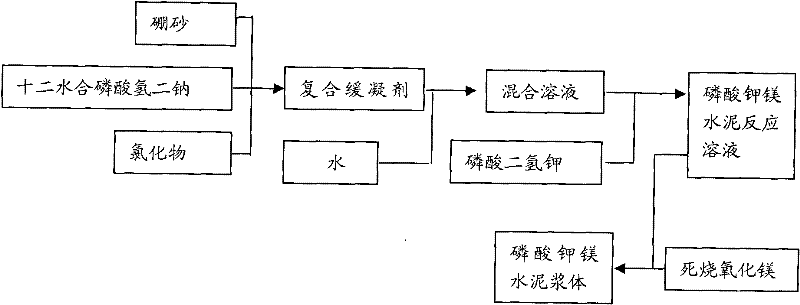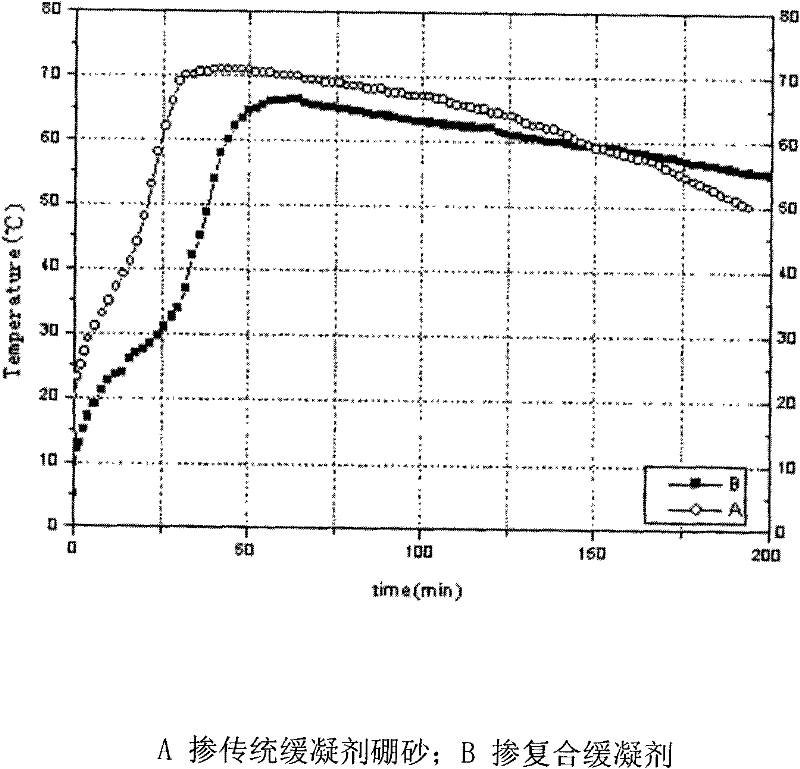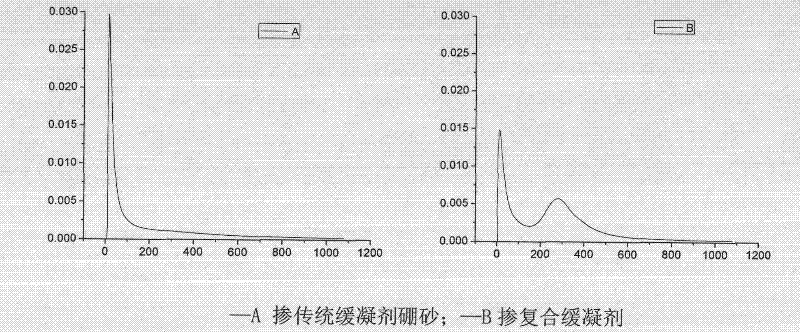Method for controlling setting time and early hydration speed of magnesium potassium phosphate cement
A technology of potassium magnesium phosphate cement and setting time, which is applied in the field of early-strength and fast-hardening cement cementitious materials, can solve problems such as difficult control, insignificant retardation effect, and side effects, and achieves poor operability and retardation effect. limited effect
- Summary
- Abstract
- Description
- Claims
- Application Information
AI Technical Summary
Problems solved by technology
Method used
Image
Examples
Embodiment 1
[0036] The traditional retarder borax, which accounts for 10% of the cement mass, is mixed into the potassium magnesium phosphate cement. First, the borax and potassium dihydrogen phosphate are added to the water, and the manual control of the SJ-160 double-shaft speed cement slurry mixer is used at room temperature. Procedure, first stir at a slow speed for 1 to 2 minutes, then adjust to a fast rotating gear and stir for 1 to 2 minutes to prepare a potassium magnesium phosphate cement reaction solution, continue to adjust to a slow stirring gear, slowly add dead burnt magnesia, and wait to put in After completion, adjust to rapid stirring for 1 to 2 minutes to obtain potassium magnesium phosphate cement slurry (A).
[0037]In the same ratio of potassium magnesium phosphate cement mixed with a composite retarder accounting for 10% of the cement mass, the composite retarder is added to the water, and at room temperature, use the manual control program of the SJ-160 double-shaft ...
Embodiment 2
[0042] Add composite retarder to potassium magnesium phosphate cement, adjust the amount of chloride in the composite retarder, add composite retarder with different chloride content into water, and use SJ-160 type biaxial speed at room temperature The manual control program of the cement slurry mixer, stir at a slow speed for 1 minute, add potassium dihydrogen phosphate, continue to stir at a slow speed for 1 to 2 minutes, and then adjust to a fast rotation gear and stir for 1 to 2 minutes to obtain a potassium magnesium phosphate cement reaction solution. Continue to adjust to the slow stirring gear, slowly add dead burnt magnesia, and after the addition is completed, adjust to fast stirring for 3 to 5 minutes to obtain potassium magnesium phosphate cement slurry.
[0043] The coagulation time of the slurry was tested with a Vicat instrument at an ambient temperature of 20° C., and the compressive strength of the hardened body was tested with a cylindrical specimen of diamete...
Embodiment 3
[0047] Add composite retarder in potassium magnesium phosphate cement, adjust the dosage of disodium hydrogen phosphate dodecahydrate in the composite retarder, add composite retarder with different dosage of disodium hydrogenphosphate dodecahydrate into water, At room temperature, use the manual control program of the SJ-160 double-shaft speed cement slurry mixer, stir at a slow speed for 1 minute, add potassium dihydrogen phosphate, continue to stir at a slow speed for 1 to 2 minutes, and then adjust to the fast rotation speed for 1 to 2 minutes. Minutes to obtain the potassium magnesium phosphate cement reaction solution, continue to adjust to the slow stirring gear, slowly add dead burnt magnesia, after the addition is completed, adjust to fast stirring for 3 to 5 minutes, and obtain potassium magnesium phosphate cement slurry.
[0048] The coagulation time of the slurry was tested with a Vicat instrument at an ambient temperature of 20° C., and the compressive strength of ...
PUM
 Login to View More
Login to View More Abstract
Description
Claims
Application Information
 Login to View More
Login to View More - R&D
- Intellectual Property
- Life Sciences
- Materials
- Tech Scout
- Unparalleled Data Quality
- Higher Quality Content
- 60% Fewer Hallucinations
Browse by: Latest US Patents, China's latest patents, Technical Efficacy Thesaurus, Application Domain, Technology Topic, Popular Technical Reports.
© 2025 PatSnap. All rights reserved.Legal|Privacy policy|Modern Slavery Act Transparency Statement|Sitemap|About US| Contact US: help@patsnap.com



